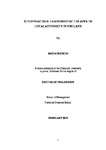FLUID FRACTALS: LEADERSHIP AT THE APEX OF LOCAL AUTHORITY IN ENGLAND
| dc.contributor.supervisor | DUCKETT, HILARY | |
| dc.contributor.author | TRIPATHI, SMITA | |
| dc.contributor.other | Plymouth Business School | en_US |
| dc.date.accessioned | 2015-01-06T14:28:26Z | |
| dc.date.available | 2015-01-06T14:28:26Z | |
| dc.date.issued | 2013 | |
| dc.identifier | 209474 | en_US |
| dc.identifier.uri | http://hdl.handle.net/10026.1/3186 | |
| dc.description.abstract |
Purpose: This thesis aims to explore the complex phenomenon of leadership at the apex of democratically elected local authority in England. It makes sense of the social construction of leadership as perceived and enacted by senior appointed officers (hereinafter officers), elected members (hereinafter members) and key stakeholders – the voices from the apex and their understandings and interpretations. Design/methodology/approach: The thesis examines leadership literature through the paradigm of constructivism-interpretivism, making sense of transcripts of the semi-structured interviews with officers, members and stakeholders engaged in local authority work. Dominant/mainstream theories of leadership offer limited help to understanding the relational, processual constructions of leadership and is critiqued. One way forward is to rethink conceptualisation of leadership in terms of the empirical evidence through interviews. This research has explored how leadership is situated, shared and occasioned, processed and deployed as narratives between officers and members. Findings: The constructivist-interpretivist findings of the research challenges the dominant essentialist hegemony of existing leadership theories, where heroic leaders and their skills and competencies can be replaced by less individualistic and more critical constructs through the four lenses which draw together in the fractal of leadership. This moving, forming and reforming, dynamic model highlights: i) the context in which leadership is situated and performs, ii) the shared and relational nature of leadership in interactions and continuous happenings, and the web of roles and relationships between powerful actors, which are perpetually evolving and contextualising, iii) the doing of leadership with its focus on interactive processes and practices, and iv) the narratives of leadership including the language games, the rhetoric, the metaphors and symbols which can challenge as well as reinforce the existing patterns of leadership as they emerge and mould and are moulded in diverse patterns. Research limitations/implications: Though the findings themselves cannot always be generalised to other contexts, the four frames of the fractal provide theoretical perspectives for studying leadership in other contexts. Originality/value: By challenging the dominating mainstream and public leadership theories, the four theme leadership framework allows for the incorporation of dynamic lenses to study the complex social phenomena of leadership. The analogy with a kaleidoscopic fractal enables a rich understanding of leadership rooted in a specific context yet with endless possibilities of leadership built from the permutations and combinations of the four themes. This thesis makes a theoretical and empirical contribution to the questions of the how, why and what of organisational leadership, both in a broad sense and in the specific context of the public sector and local authority in particular. | en_US |
| dc.language.iso | en | en_US |
| dc.publisher | Plymouth University | en_US |
| dc.subject | Leadership | en_US |
| dc.subject | Public | |
| dc.subject | Managerial | |
| dc.subject | Political | |
| dc.subject | Apex | |
| dc.subject | Local Authority | |
| dc.subject | Governance | |
| dc.title | FLUID FRACTALS: LEADERSHIP AT THE APEX OF LOCAL AUTHORITY IN ENGLAND | en_US |
| dc.type | Thesis | |
| plymouth.version | Full version | en_US |
| dc.identifier.doi | http://dx.doi.org/10.24382/3642 | |
| dc.identifier.doi | http://dx.doi.org/10.24382/3642 |
Files in this item
This item appears in the following Collection(s)
-
01 Research Theses Main Collection
Research Theses Main


